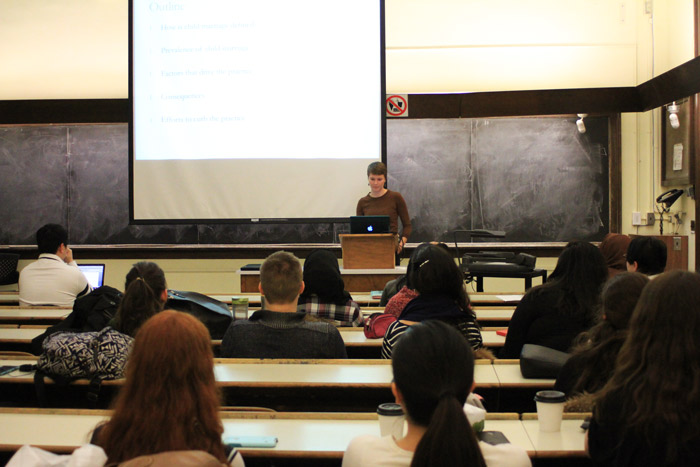On Feb. 4, the Comparative Healthcare Systems Program (CHSP) invited Alissa Koski, a Doctoral Fellow at the Institute for Health and Social Policy and a PhD Candidate in the Department of Epidemiology at McGill, to present an hour-long talk on the issue of child marriage worldwide. An estimated one in three girls are married before eighteen in the developing world, with 39,000 child marriages happening every day.
Root causes
In her speech, Koski highlighted the commonality of the practice. Despite it being classified according to several international agreements as a violation of human rights, including the Universal Declaration of Human Rights, child marriages are common in developing countries around the world.
“The highest rates come from Niger and Mali,” Korski said. “In Sub-Saharan Africa, [child marriage] rates go up to eighty-percent of girls.”
She added that child marriage does not only take place in developing countries; children can be married under eighteen with parental consent in Canada and the United States. Reasons why this practice occurs lie both in economics—countries with the highest rates of child marriage are often among the poorest—and collective social values.
“The reasons for marrying girls off are quite diverse,” Korski said. “The one theme that ties them altogether is gender inequality.”
Bride price, a practice where the groom’s family transfer material possessions, usually in the form of money or livestock to the bride’s family, is a commonly used tactic to trap girls into marriage by taking advantage of their family’s economic condition.
“Frequently, when marriages fail, grooms can demand a return of the bride price in a lot of Sub-Sharan Africa,” Korski explained. “Many girls feel trapped, and they know that their family won’t be able to return items or cash that was given at the time of marriage.”
Effects
Studies point out that child marriage leads to high lifetime fertility, multiple unwanted pregnancies and sexual violence—girls married as children often perceive their first sexual contact as unwanted. Children of early marriages are also likely to suffer from low birth weight and cervical cancer, most likely from contracting the HPV virus.
Nevertheless, Korski cautioned that we should not immediately draw conclusions between child marriage and the problems associated with it.
“It is unclear whether these risks are higher because the girls got married under the age of 18, or because they are poor,” she said. “Is it child marriage that causes these poor outcomes or is it a fact that all those girls who get married as children are from poor households?”
Solving the problem
Efforts have been made to curb the practice of child marriage. Korski cited a program known as “Apni Beti Apna Dahn,” an effort led by the government of Haryana in India to improve women’s status and delay child marriage. When a girl is born, the family is given 500 rupees, or approximately $10 CAD. If the girl is eighteen and unmarried, an additional 25,000 rupees, approximately $500 CAD, will be given to the family. The payout increases if educational attainment goals were met.
A study conducted by the International Center for Research on Women found that this program had no effect on the probability of girls getting married before eighteen, but resulted in a significant increase in the number of girls married at exactly the age of eighteen. Although girls were 12 per cent more likely to complete eighth-grade, they were no more likely to complete twelfth-grade.
“This is why it’s very important to evaluate these programs,” Korski warned. “Things that we think intuitively should work very well can in fact have unintended consequences [….] Improving educational and economic opportunities for girls are likely to be more effective at reducing child marriage than existing laws.”









